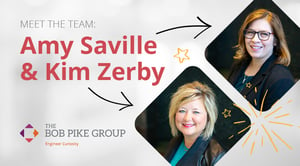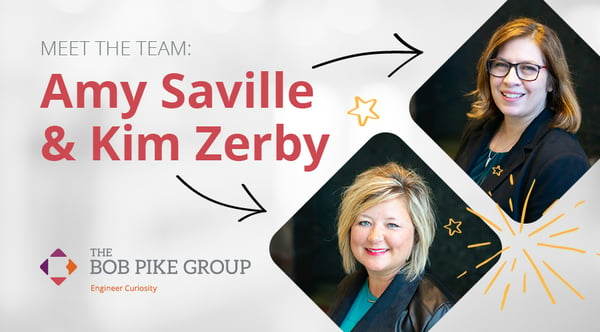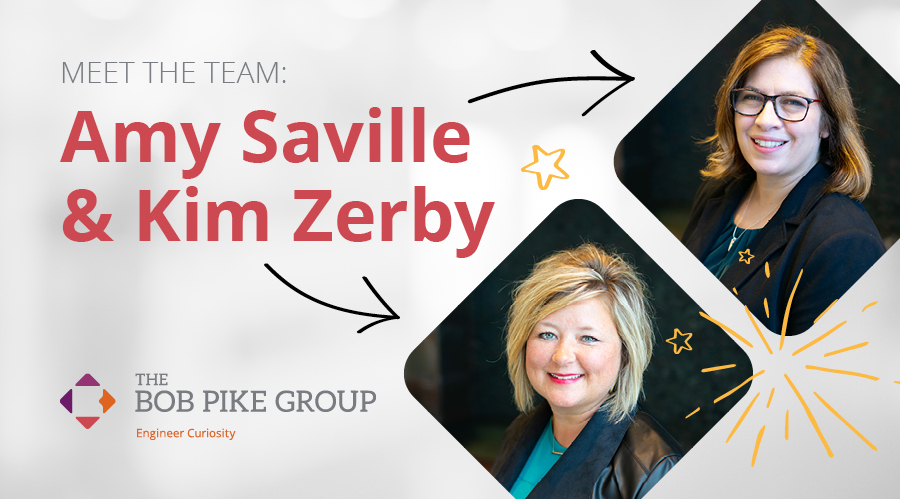


After a national search, 250 highly qualified applicants, and a dozen stellar finalists, The Bob Pike Group is fortunate to welcome two new training consultants to the team!
Amy Saville (LCSW, MSW) and Kim Zerby (M.Ed.) together bring decades of experience to The Bob Pike Group. We recently sat down with Amy and Kim to hear more of their background and what they’re excited to bring to The Bob Pike Group. Grab a pen, because they offer a lot of great advice. Read on to find out what they had to say!
Amy:
I’m a clinical social worker and I began training in 2004, when the youth detention center where I was assigned asked if I could train their officers about suicide prevention. After I did that, I was asked to present at a conference for the New Jersey Juvenile Detention Association, where the Director of Training for the New Jersey Juvenile Justice Commission sat in my class. From there, I became involved in a statewide project to train all the staff in the youth detention centers in New Jersey on the topic of working with youth with mental health disorders and trauma. I grew to love training as much as I loved clinical work. In 2006, I was offered a full-time position as a trainer for juvenile justice professionals through Rutgers University. I’m still in this position today!
Kim:
I thrive when I’m helping others learn! As a teacher for over a decade, I love interacting with my students as well as writing/creating lessons with my colleagues to be interactive and engaging. After a decade of teaching, I joined the digital technology side of education and had the opportunity to train teachers online. With a diverse background in education, I would say training has always been a part of my career.
Amy:
In 2007, I was invited to join The Bob Pike Group’s Train-The-Trainer Boot Camp. Was I glad I did! It was simply the best training I had ever been through and it completely transformed the way I did my work. After, I went through all of my existing curriculum and “Pike-ified” it, to great success. I always credit The Bob Pike Group with making my career here at Rutgers.
Kim:
As a trainer for a digital technology company, I had the opportunity to attend The Bob Pike Group’s Train-The-Trainer Boot Camp as a participant. This completely transformed our face-to-face trainings as well as online trainings. With the tools we learned, we could immediately implement and see instant results. Witnessing firsthand the techniques The Bob Pike Group teaches to increase retention as well as experiencing the excitement and energy participants leave with, I knew I wanted to be a part of this in other industries, too.
Amy:
It’s all right there in the phrase "participant-centered.” When you put your learners at the heart of your work, you’re going to naturally do things that serve them better. Often trainers focus on the information they are trying to share, rather than the people they’re delivering it to. That’s backwards. When we focus on creating connections with and among our participants and using our content to forge those connections … learning is the natural outcome.
Kim:
The trainings are designed with application time built into the course. This allows various group sizes, generations, and organizations opportunity to adapt, adopt, and apply the instructor lead-participant centered model to make content memorable and immediately usable.
Amy:
My co-workers at The Bob Pike Group! We have such a strong, talented network of training consultants at The Bob Pike Group. Whenever I’m in need of a boost, my colleagues are a text message away with support, ideas, tips, and the resources I need to get the job done. And our office staff is top-notch. They’re constantly fixing problems, making sure we have what we need to do our jobs, and taking care of all those things large and small, from registration to evaluation … that make the learning experience worthwhile for our participants.
Kim:
Surrounding myself with positive like-minded people who can let me “vent” when necessary, but always know how to build me up. Podcasts and trainers’ blogs are a great way to keep up to date on current training trends.
Amy:
I personally love putting participants in learning families and watching them warm up to each other. They have a lot of fun creating their learning family name, poster, logo, and motto. It’s such a great way to learn a little about everyone in the group and to get a sense of who they are outside their professional roles.
Kim:
My favorite opener is the “Robbed Museum.” This opener is best for a multi-day training. To everyone’s shock and amazement, we get robbed from our flipchart museum during lunch. Strangely they only take our C.O.R.E. posters. I like this opener because each table group has to collaborate together to recreate the flipchart poster—then they must explain what they drew with examples. This opener could be used as a re-visitor or closer, as well!
Amy:
Most adult learners want to feel like their time is being well-spent, and sadly much of the time they don’t feel that way at all. This is where participant-centered approaches really make a difference. When people make connections with other participants and are actively engaged with your content, they feel like they spent their time doing something worthwhile.
Kim:
Learners want brain breaks in the training with time to process! A typical trainer has a crammed PowerPoint deck that is full of heavy content. The trainer uses the “spray and pray” method. (Spray a lot of content and pray something sticks!) This causes the learners to have that glassed-eye look we see too often. It’s as effective as asking them to take a sip from a fire hose! With The Bob Pike Group, we incorporate the 90/20/10 rule. By giving learners a physical break every 90 minutes, a mental break every 20 minutes, and involving them every 10 minutes—we provide them an opportunity to understand and have increased retention. All too often I hear trainers say, “If I skip the break, I can end training early.” It’s imperative that we give learners an opportunity to digest the content we are feeding them before we feed them another serving.
Amy:
This style of training allows the participants to help create the learning experience for themselves and each other. They run small-group discussions, they help create the materials, and they help teach back the topics that are covered. You can see in real time that the more they are doing, the more they are learning. This style of training also makes my job so much more fun and rewarding. When you see people laughing, learning, and making new connections, it is such a feeling of satisfaction. I always leave The Bob Pike Group’s trainings on a high note!
Kim:
Using the instructor lead-participant centered training methods, the trainer becomes the guide on the side instead of the sage on the stage. The less they hear my voice … the better!
Amy:
First, stay current on your subject. If we’re at the front of the room, we need to be as up-to-date as we can be on our topic. Set a Google alert, subscribe to podcasts, and read the scholarly and popular articles in your field on a regular basis. Second, no matter the venue or subject matter, plan activities that allow participants to interact and share their ideas with other participants. Many of us process ideas through talking, and this also allows us to share our unique perspectives on the subject. Third, incorporate variety! There are so many ideas The Bob Pike Group offers for how to infuse training with a variety, from mind mapping to gallery walks. When we incorporate a variety of methods, we keep our participants engaged, and we appeal to different personalities and learning preferences. People will leave feeling like they got something they couldn’t get from a book or an article—and that’s really what makes live training valuable.
Kim:
Essential elements for trainers must be FLEXIBILITY, PLANNING (attention to details), GOOD LISTENING SKILLS, and EXPERIENCE.
Amy:
Aside from the training-specific supplies (like markers, name tags, blank paper) I always have my water bottle, mints, and usually a cup of coffee! In the afternoon it’s probably a Diet Coke.
Kim:
Besides the essential technology components … computer, mouse, USB drive, slide clicker, cell phone, charging cables, speakers, music—I always carry a refillable water bottle, comfortable shoes, and lipstick!
Amy:
Becky Pike Pluth wrote an entire book about this. But in a few words, I always start by giving difficult participants the benefit of the doubt. I assume they have a valid reason for behaving that way, and if necessary, I approach them privately at a break to ask how I can make the experience better for them. If the entire group is resistant, I ask them to teach me about what they do, so I can make the content more relevant for them. I always start by making an alliance. But here is the truth—when you use participant-centered techniques, you don’t get that many difficult behaviors in your training! People are too busy learning, and the group itself manages to minimize those behaviors without the trainer doing much at all.
Kim:
It’s been said “An idle hand is the devil’s workshop.” If participants have nothing to do, they are likely to do something to disrupt the class. Keeping participants actively engaged and involved in the training will automatically cut out many challenges that arise.
Amy:
The big difference in The Bob Pike Group’s approach is that it’s very intentional about the experience for the learner. We design training with the participant as the priority, not the content or the instructor. It may sound counterintuitive when you have a lot of important content to deliver, but The Bob Pike Group’s focus on the result—getting people to actually use the content—is what makes this approach work. Most training centers the content as the highest priority. In that approach, people may receive a lot of information, but that doesn’t mean they engage with it. With The Bob Pike Group’s Creative Training Techniques®, participants process the content, talk to other participants about the content, and even make commitments about how to use it going forward. Once you’ve tried training this way way, you never go back to “Death by PowerPoint.” That’s because it works!
Kim:
The research behind the why.
Join us in welcoming Amy and Kim to the team! And discover for yourself the training wins you can achieve if you incorporate Creative Training Techniques® into your regimen like Amy and Kim have done. Sign up for a train-the trainer workshop today and learn how instructor-led, participant-centered training helps trainers cover twice as much in half the time. It’s guaranteed to make your job easier and your training more fun.
Meet Amy at Train-the-Trainer Boot Camp in Nashville, May 7-8
Meet Kim at Train-the-Trainer Boot Camp in Minneapolis, March 17-18
Don't miss out on updates and chances
to sharpen your skills with participant-centered learning.




3740 N Chestnut St #113 - Chaska, MN 55318-3053